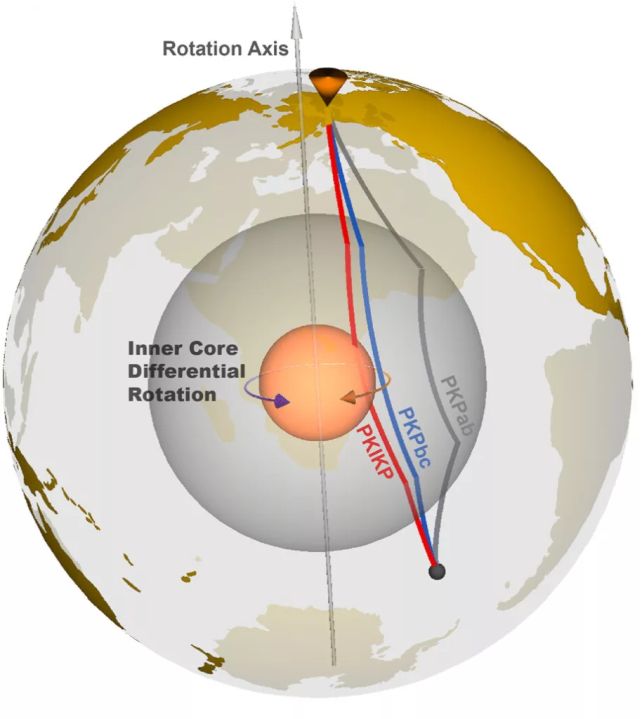The internal, infernal machinations of our planet may be way more complex than we suspected.
A new, detailed probe of Earth’s heart reveals that the rotating inner core doesn’t just change in rotation speed – it also appears to change in shape, with subtle variations appearing in the way acoustic waves propagate through the planetary center.
This is a wild discovery, one that will lead to a better understanding of how the core works – which in turn will shed light on other strange ways Earth behaves.
“Spotting a process that was previously undocumented is a thrill,” geophysicist John Vidale of the University of Southern California told ScienceAlert. “We’re always hoping to find the next weird and profound fact, and this observation is brand new. The next step will be making sure we’re right, and honing our models.”
Earth’s solid inner core represents one of the most mysterious engines in geophysics. It’s rotating around down there, wrapped in a cushioning shell of molten outer core, inexorably tied to planetary behaviors such as the length of the day, and the geomagnetic field spun out into space by the electromagnetism generated by its motion.
Because the core plays such an important role in planetary processes, scientists are champing at the bit to find out exactly what’s going on there. But, well, we can’t go down and look at it. Luckily, our planet has given us a way to take measurements of its interior: earthquakes. When Earth’s crust cracks and shakes, acoustic waves reverberate around, propagating through or bouncing off the different materials it encounters therein.
Scientists can then analyze the waves received by seismic monitoring stations around the world to take measurements of the planet’s core. We know, for example, that Earth’s inner core is probably a hot, dense ball of solid iron and nickel, measuring roughly 2,440 kilometers (1,516 miles) across, a little bigger than the size of Pluto. Evidence also suggests that it demonstrates superrotation, rotating faster than Earth itself, though it may have slowed in recent years.
Using earthquake data, Vidale and his colleagues have been working for years to unveil the mysteries of the inner core. In 2022, they published a paper describing what appeared to be a link between a change in the inner core’s rotation speed, and a periodic change in the length of Earth’s day. Further investigation revealed that there is no link after all.

If we want to be able to accurately link the behavior of the core to the effects that behavior has on the planet as a whole, we need to characterize the behavior accordingly, Vidale notes.
Now, it has been pretty well established that the rotation of the inner core changes speed, and obviously that rotation speed is different from the planetary rotation. But there’s a variability in the seismic waves that bounce off the core that is difficult to pin down: is it due to a variability in rotation speed, or a variability in the core’s shape?
To understand this phenomenon, Vidale and his team studied 168 pairs of repeating earthquakes that traveled through the planet.
“Each repeating pair is two earthquakes that are nearly identical,” he explained, “such that we can associate any changes we observe with a difference in the path along which the seismic waves traveled.”
They compared their earthquake pairs from times when the inner core was re-occupying the same position, which meant they could rule out a change in rotation rate for variations in the seismic signal. Their results showed differences in the waves grazing the surface of the inner core, at the boundary between the inner and outer cores – suggesting that there were variations in the core’s shape.
frameborder=”0″ allow=”accelerometer; autoplay; clipboard-write; encrypted-media; gyroscope; picture-in-picture; web-share” referrerpolicy=”strict-origin-when-cross-origin” allowfullscreen>
So what does that look like?
“Hard to be sure, but possibly it would be minor depressions and uplifts in the inner core boundary in response to the vigorously flowing outer core,” Vidale said. “It’s possible the changes are entirely within the inner core, but that is less likely. Guiding our guess is the fact that the inner core is right at its melting point at its surface, and so could be quite soft.”
There are a number of possible causes for this, but chief among them is the pull of regions of higher density material inside our planet, known as large low-shear-velocity provinces. It’s also possible that convective flow in the outer core could drag on the inner core to change its shape. Or maybe both.
But what’s really cool here is that the signals in the seismic data can be attributed to two changes in the inner core: a change in rotation rate, and a change in the shape. And of course Vidale and his colleagues are going to continue to investigate.
“More data is usually the best way to better understand new claims,” Vidale said. “The inner core, if it continues to spin in the direction it has been going for the last 15 years, will return soon to where it was around the year 2000, when it might have done some interesting things. The next few years will be enlightening.”
The research has been published in Nature Geoscience.




